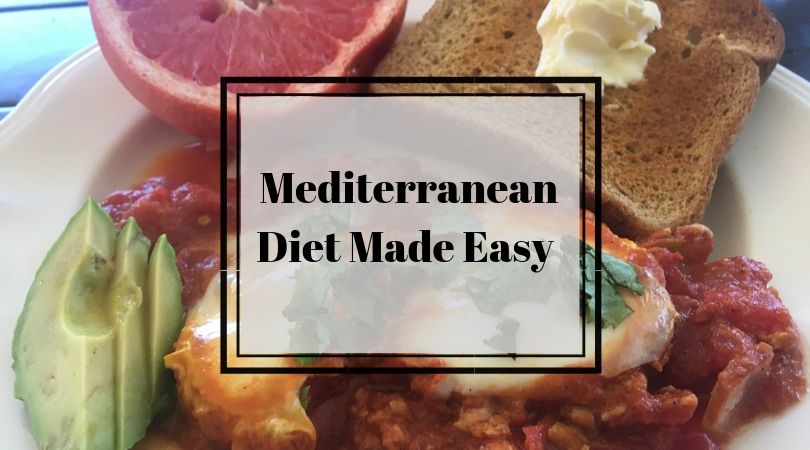Meal Planning on a Mediterranean Diet (with free printable Mediterranean diet checklist)
Meal planning takes many forms depending on your lifestyle, budget, and personality. It doesn’t necessarily have to be a fully written-out meal plan. Some people prefer to plan only a couple of days in advance. Others prefer to buy groceries for a few different meals then have a bit more flexibility.
For the last two weeks I’ve been following a Mediterranean Diet (you can read more about it here). I’ve learned some tricks to make following this eating pattern a bit easier with meal planning. If you’re new to meal planning, first check out this post for my step-by-step instructions on making a meal plan. In today’s post, I’ll give you some ideas I’ve picked up in the last few weeks for meal planning on a Mediterranean Diet.
Keep Track
The Mediterranean diet pyramid has specific guidelines for how many servings of different items to eat per day or per week. When making a meal plan, it can be helpful to keep track of these groups (particularly the protein sources) to make sure you’re aiming in the right directions. I’ve created a free printable Mediterranean Diet checklist that you can download here to help. Even if you don’t follow these guidelines exactly (in fact, I’d recommend that you give yourself a little wiggle room), this checklist can keep you from straying too far from recommendations.
Leave yourself some flexibility
Some of the recommended serving amounts are quite limited (like 1 serving processed meat and 2 servings sweets per week). Because of that, I find it helpful to plan for fewer servings than the recommendations allow. This gives you the opportunity to have flexibility throughout the week in different social situations (or if you’re just tuckered out). For example, I didn’t include processed meat in my weekly plan and I only included one serving each of red meat and chicken (2 each are allowed). This meant that if I ended up in a place where processed meat was on the menu (high school football game hot dog, anyone?), I had the opportunity to choose it. One day when my son scored his first job, we wanted to celebrate with some DQ blizzards, and since I didn’t build sweets into my meal plan, I indulged without having to go over, go without, or change my meal plan.
Plan around your life
Along those lines, check out your calendar when you’re making your meal plan. If you know that you’re going to be eating a soul dinner (hello, football game!), try to load the rest of your day with the nutritious foods you’re not likely to get there. On the Friday I knew I was headed to the game, I knew I would get nachos and a hot dog for dinner (not much in the way of veggies or fruit) so I had a veggie scramble for breakfast, plenty of salad with veggie soup for lunch, and a couple of fruits for snacks.
I tried to check all those boxes before I went to the game to make it easier to follow Mediterranean Diet recommendations while still enjoying my social life!
Work with Family Dinners
Even if you decide to aim for a Mediterranean Diet eating pattern, the people you eat with may or may not be on board to eat the same way. These differing preferences can be a struggle – family members or partners don’t always make healthy changes in the same ways or at the same paces. Try to work with this when making your meal plan. If there are meals where you won’t be eating with your family members (lunches are commonly eaten separately, for example), plan for those to include the protein sources that aren’t limited like seafood or legumes. Shared meals (often dinners) can use some of the more limited protein sources like chicken, pork, or beef that your family members would want to enjoy.
Another trick for meal planning with a family is to include a balance of what I call “combo dinners” and “compartment dinners.” Combo dinners are meals like casseroles or soups where everything is mixed together. These are the types of meals where it makes the most sense to use the limited proteins like chicken or beef. Compartment meals are meals where each item is separate (usually in a meat + starch + vegetable configuration). These are good opportunities to make yourself a different protein from the rest of your family. It’s helpful to choose one that can be prepared and cooked in the same way as the rest of your family’s meal. For example, if the meal is baked chicken with vegetables and mashed potatoes, simply bake enough chicken breasts for the rest of your family and on the same pan, bake yourself a fish fillet. You’re not making an entirely separate dinner, just giving yourself some flexibility to eat with your family and still meet Mediterranean Diet recommendations.
Hopefully these tips are helpful to you as you aim to improve your health! The key is to make changes gradually, never expect perfection, and work with your lifestyle and personality, not against them. You can do it!
You Might Also Like
How to Meal Plan on a Budget (step-by-step walkthrough)
The Must-Try Meal Planning Hack to Stop Wasting Time and Money






Leave a Comment